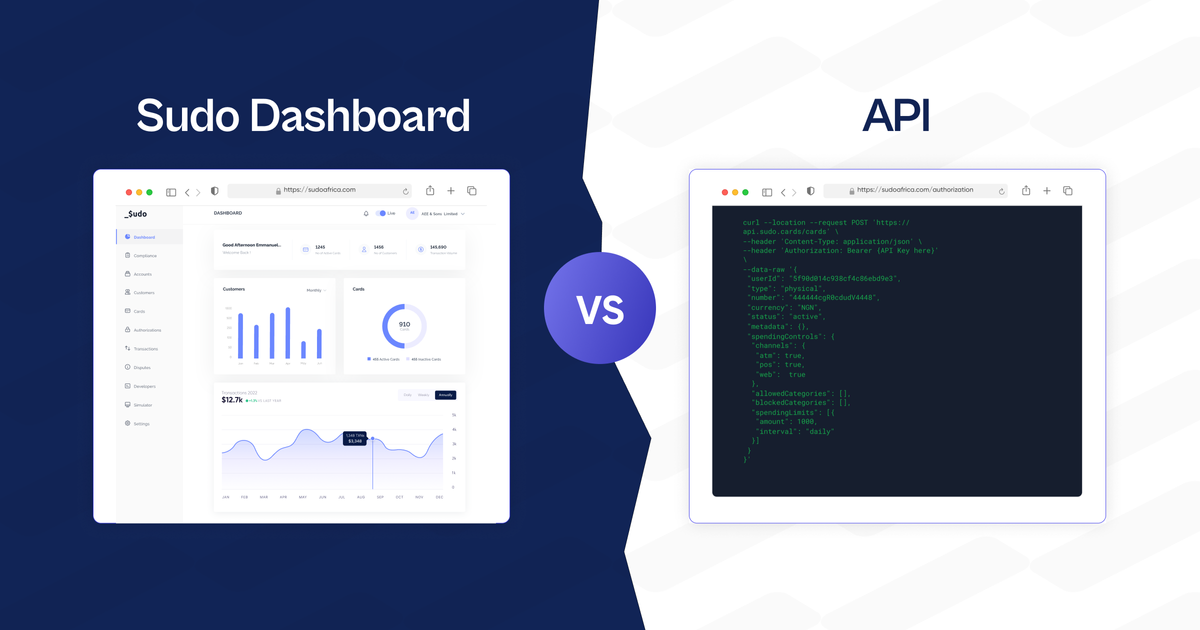Sudo Dashboard Vs API: What You Should Know

The demand for card issuance infrastructure has grown significantly in the last few years due to the emergence of fintech companies that require to issue cards.
To help businesses to issue payment cards and enhance the user experience, Sudo offers two tools: the Sudo Dashboard and the Sudo API (Application Programming Interface). Fundamentally, they serve the same purpose by providing access to product data but work in very different ways for different use cases.
The moment a customer decides to integrate the Sudo infrastructure into their business operational flow, they are faced with the challenge of choosing between using the dashboard or API.
In this blog post, we will explore the differences between the two options and provide a guide in choosing the best approach for the fulfilment of customers business operational goals.
When you leverage the Sudo Dashboard or API integration, your team gains enhanced efficiencies with solutions such as:
- Instant issuance of virtual and physical NGN/USD cards.
- Flexible controls on every card including setting spending limits, blocking specific business categories, enabling and disabling spending channels for each card, etc.
- Real-time transaction approvals.
- Creation and management of local and international virtual accounts.
- An efficient and well-structured account and data management system.
What is the difference between the Sudo Dashboard and the Sudo API?
The Sudo dashboard is a graphical user interface (GUI) that contains a visual representation of data such as financial transactions, programmable card features, and other key metrics for which the product was designed. It consists of charts, graphs, and other visualizations that make it simple for users to understand the complex information in one centralized location. The Sudo dashboard, typically used by non-technical users who need to manage expenses and issue physical & virtual cards, has been designed to be very user-friendly and can easily be customized to serve different use cases.
The Sudo API, on other hand, is a software intermediary that allows two applications to talk to each other. APIs are an accessible way to extract and share data within and across organizations. Essentially, the software is outlined to include the programming of all the features of the infrastructure. It is accessible for stakeholders who are looking to leverage those features in building their unique product/ infrastructure. One of the key benefits of using API is that it provides direct access to product data and has a high degree of flexibility. Stakeholders can customize the Sudo API to meet their specific needs, allowing them to access the required tools.
When deciding whether to use the dashboard or API, there are a number of factors to consider.
- Technical Expertise: Using the dashboard requires little to no technical expertise, as it is designed to be user-friendly. However, using the API requires a certain level of technical expertise. Stakeholders would need to be able to build software applications that integrate with the infrastructure.
- Customization: The API provides more flexibility and customization options than the dashboard. Stakeholders have the ability to build software applications that are tailored to their specific needs, rather than relying on the pre-built functionality of the dashboard.
- Speed: Integrating the API can be faster than using the dashboard, as it enables processes to be triggered automatically. This can save time and reduce the risk of human error which can arise by utilizing the dashboard directly.
- Security: Both the dashboard and API are secure, but stakeholders should ensure that they have appropriate security measures in place to protect user data and financial transactions.
Ultimately, the decision to use the dashboard or API is dependent on the specific needs of the stakeholders and their use cases. The dashboard is best suited for users with low technical expertise who require a user-friendly interface for expense management and company expense cards. On the other hand, for a modern fintech, with the technical resource to build a software, looking to include card issuance into their product and requiring customizable options, the API may be a better choice. It is imperative that stakeholders weigh the pros and cons of each option before making a decision.
To get started on Sudo as a business, visit our website here. If you’re an individual looking for a virtual card for online payments or a physical card for ATM and POS payments, download our mobile app, Root by Sudo on the iOS App Store here or Google Play Store here.




